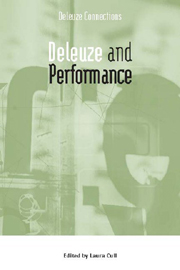Book contents
- Frontmatter
- Contents
- Introduction
- 1 Performing in the Chaosmos: Farts, Follicles, Mathematics and Delirium in Deleuze
- Act I Deleuze on Theatre: Artaud, Beckett and Carmelo Bene
- Interval
- Act II Confronting Deleuze and Live Performance
- Interval
- Act III A Digital Deleuze: Performance and New Media
- 11 Like a Prosthesis: Critical Performance à Digital Deleuze
- 12 Performance as the Distribution of Life: From Aeschylus to Chekhov to VJing via Deleuze and Guattari
- 13 The ‘Minor’ Arithmetic of Rhythm: Imagining Digital Technologies for Dance
- Notes on Contributors
- Index
11 - Like a Prosthesis: Critical Performance à Digital Deleuze
from Act III A Digital Deleuze: Performance and New Media
Published online by Cambridge University Press: 12 September 2012
- Frontmatter
- Contents
- Introduction
- 1 Performing in the Chaosmos: Farts, Follicles, Mathematics and Delirium in Deleuze
- Act I Deleuze on Theatre: Artaud, Beckett and Carmelo Bene
- Interval
- Act II Confronting Deleuze and Live Performance
- Interval
- Act III A Digital Deleuze: Performance and New Media
- 11 Like a Prosthesis: Critical Performance à Digital Deleuze
- 12 Performance as the Distribution of Life: From Aeschylus to Chekhov to VJing via Deleuze and Guattari
- 13 The ‘Minor’ Arithmetic of Rhythm: Imagining Digital Technologies for Dance
- Notes on Contributors
- Index
Summary
It is not surprising that, among the many of the authors who promote it, structuralism is so often accompanied by calls for a new theatre or a new (non-Aristotelian) interpretation of the theatre: a theatre of multiplicities opposed in every respect to a theatre of representation, which leaves intact neither the identity of the thing represented, nor author, nor spectator, nor character, nor representation which, through the vicissitudes of the play, can become the object of a production of knowledge or final recognition. Instead, a theatre of problems and always open questions which draws spectator, setting and characters into the real movement of an apprenticeship of the entire unconscious, the final elements of which remain the problems themselves.
(Deleuze 1994: 192)While the work of Gilles Deleuze might not always resemble a theatre of problems, it consistently grounds its readings of philosophy and its musings on cinema and art in the always open question of representation. Indeed, Deleuze opens the philosophical text framing his lifelong project, Difference and Repetition, by contrasting the theatre of representation with the more dynamic theatres of movement and repetition. The theatre of representation, whether on the classical stage or the philosophical page, is said to subscribe to a naturalised reliance on the presentation of ‘sameness’. This sameness of representation revolves around the quadripartite structure of representation that neatly aligns and contains text, perception, and subjectivity: the identity of concepts, the opposition of predicates, the analogy of judgement, and the resemblance of perception.
- Type
- Chapter
- Information
- Deleuze and Performance , pp. 203 - 220Publisher: Edinburgh University PressPrint publication year: 2009



